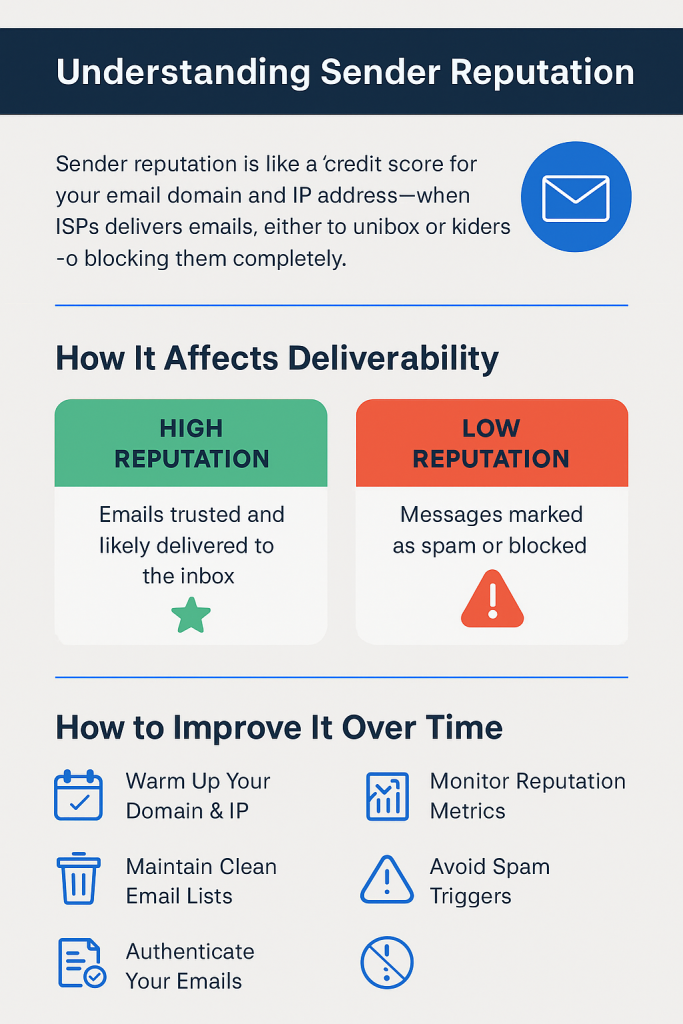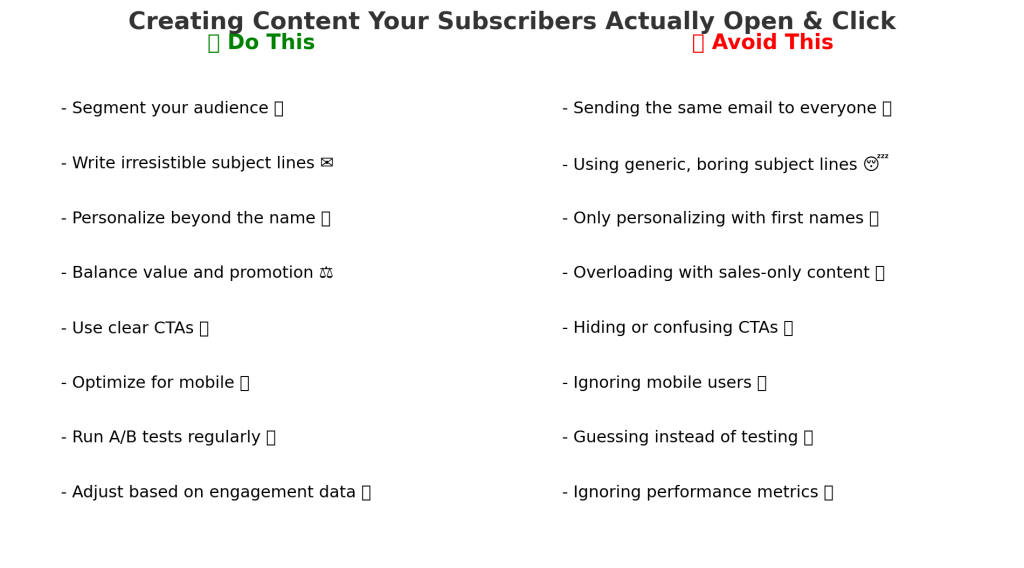Sender reputation is like a credit score for your email domain and IP address — it’s the score that Internet Service Providers (ISPs) like Gmail, Yahoo, and Outlook use to decide whether to deliver your emails to the inbox, the promotions folder, the spam folder, or block them entirely.
Every time you send an email, ISPs look at your sending history, engagement rates, complaint levels, and authentication records (SPF, DKIM, DMARC) to determine your trustworthiness. A poor sender reputation means your emails are more likely to land in spam, while a strong one increases the chances of consistent inbox placement.
How Sender Reputation Affects Email Deliverability
Email deliverability is the ability of your email to successfully reach the recipient’s inbox. Sender reputation plays a direct role here:
- High Reputation: Your emails are trusted, often bypassing spam filters and appearing at the top of the inbox.
- Low Reputation: Your messages get filtered into spam or blocked before they’re even delivered.
ISPs track the following key factors to determine reputation:
- Spam complaint rate – If too many people mark your emails as spam, your score drops.
- Bounce rate – Sending to invalid email addresses signals poor list hygiene.
- Engagement rate – High open and click rates boost your reputation; low engagement hurts it.
- Sending patterns – Sudden spikes in email volume or irregular sending schedules raise red flags.
- Email Authentication – Lack of SPF, DKIM, and DMARC records weakens your trust score.

How to Improve Sender Reputation Over Time
Improving sender reputation is a gradual process. Here’s how to steadily build trust and boost deliverability:
1. Warm Up Your Domain & IP
Warming up your domain and IP address is a critical step for ensuring your emails reach the inbox, especially if you are starting with a new domain or sending from a new IP. Email service providers (ESPs) evaluate sender behavior carefully, and suddenly sending a large volume of emails from an unknown or cold domain/IP can trigger spam filters. Warming up gradually builds trust with ESPs, signaling that you are a legitimate sender.
What warming up involves:
- Stay Consistent – Avoid sudden spikes in sending volume, even after the warm-up phase. Maintaining a consistent sending pattern further reinforces trust with ESPs.
- Start Small and Scale Gradually – Begin by sending a small batch of emails to your most engaged subscribers. Over time, slowly increase the volume each day or week, allowing ESPs to recognize your sending pattern as trustworthy.
- Focus on Engagement – Prioritize sending to subscribers who are most likely to open, click, and interact with your emails. High engagement during the warm-up phase helps build your sender reputation quickly.
- Authenticate Your Emails – Ensure your domain has proper SPF, DKIM, and DMARC records in place. Authentication signals to ESPs that your emails are legitimate and reduces the risk of being flagged as spam.
- Monitor Metrics Closely – Track bounce rates, open rates, click-through rates, and spam complaints. Adjust your sending volume or cadence based on these metrics to maintain a healthy reputation.
2. Maintain Clean Email Lists
One of the most important steps in protecting your sender reputation and maximizing email deliverability is maintaining a clean email list. A “clean” list means it contains only active, engaged, and valid email addresses. Over time, lists naturally accumulate inactive subscribers, bounced emails, or even invalid addresses that were mistyped or abandoned. Sending emails to these addresses can hurt your sender reputation because high bounce rates, low engagement, or spam complaints signal to email service providers (ESPs) that your emails may not be wanted.
To keep your list clean:
- Use List Verification Tools – Periodically run your list through verification services to detect invalid, disposable, or risky emails before sending.
- Regularly Remove Inactive Subscribers – Identify subscribers who haven’t opened or clicked your emails in six months to a year and consider either re-engaging them with a targeted campaign or removing them entirely.
- Monitor Hard and Soft Bounces – Hard bounces (invalid addresses) should be removed immediately, while repeated soft bounces may indicate temporary issues that need attention.
- Segment Based on Engagement – Prioritize sending to engaged users first and tailor campaigns to less active subscribers to try and rekindle interest before considering removal.
3. Focus on Engagement
Send content your audience wants to open and click. At the end of the day, your email performance hinges on one thing: relevance. If your subscribers don’t find your subject lines compelling or your content valuable, they won’t open—or worse, they’ll unsubscribe. Every ignored email sends a signal to inbox providers that your messages aren’t wanted, which can gradually damage your deliverability.
The solution is to deeply understand your audience and deliver content that matches their needs, interests, and stage in the customer journey. That means segmenting your list, personalizing offers, and striking a balance between value-driven content (education, inspiration, stories) and promotional messages.
When your subscribers consistently look forward to your emails, open rates rise, clicks follow, and your sender reputation strengthens. In short, the more relevant and engaging your content, the more profitable and sustainable your email marketing becomes.

4. Authenticate Your Emails
Setup SPF, DKIM, and DMARC to prove you’re the real sender and prevent spoofing. These are the basic foundational records that lets the email service providers know that you are who you say you are.
5. Monitor Reputation Metrics
Key indicators such as bounce rate, spam complaints, unsubscribe rate, and engagement (opens and clicks) give you a clear picture of how mailbox providers view your sending behavior. A sudden spike in complaints or a high volume of bounces can signal problems that need immediate attention.
By keeping a close eye on these metrics, you can spot red flags early and take corrective action—whether that’s cleaning your list, adjusting your sending frequency, or refining your content. Consistent monitoring ensures you stay in good standing with inbox providers and maintain the trust of your subscribers. Use tools like Google Postmaster Tools, Microsoft SNDS, or third-party services to track reputation trends.
🔑 Key Sender Reputation Metrics to Monitor
- Bounce Rate
- ✅ Healthy: Under 2%
- 🚩 Red Flag: Above 5% → Signals poor list hygiene or fake/invalid emails.
- Spam Complaint Rate
- ✅ Healthy: Below 0.1% (1 complaint per 1,000 emails)
- 🚩 Red Flag: Above 0.2% → Inbox providers will quickly penalize you.
- Unsubscribe Rate
- ✅ Healthy: Around 0.2% – 0.5% per campaign
- 🚩 Red Flag: Consistently above 1% → Your content or frequency may be misaligned with expectations.
- Open Rate (or Inbox Placement)
- ✅ Healthy: 20%+ (varies by industry)
- 🚩 Red Flag: Under 15% → May indicate deliverability issues or weak engagement.
- Click Rate (CR)
- ✅ Healthy: 2% – 5%+ depending on niche
- 🚩 Red Flag: Consistently under 1% → Content isn’t driving action.
- Engagement Over Time
- ✅ Healthy: Subscribers regularly open and click emails.
- 🚩 Red Flag: High “inactive” percentage (people not engaging for 90+ days) → Leads to deliverability decline.
6. Avoid Spam Triggers
Don’t use misleading subject lines, excessive salesy language, or send too frequently to unengaged users. Spam triggers are specific words, phrases, or practices that email service providers (ESPs) flag as potentially harmful or unsolicited content. This includes overly promotional language like “Buy Now,” “Free Gift,” or “Limited Time Offer,” excessive use of punctuation or capitalization, misleading subject lines, or including too many images without a balanced text-to-image ratio.
By carefully reviewing your email copy, maintaining clean and engaged subscriber lists, and adhering to best practices for email authentication, you significantly reduce the risk of being flagged as spam.
The result? Higher deliverability, better engagement, and a stronger sender reputation—allowing your emails to consistently reach the inbox where they can have maximum impact.
7. Enable Double Opt-In
When someone opts into your popup form, it automatically triggers your welcome flow series. The problem is, if they sign up using a fake or invalid email address, every message you send will bounce. This doesn’t just waste effort—it can actively harm your sender reputation and reduce overall deliverability.
That’s where double opt-in comes in. With this safeguard, new subscribers must confirm their email address before being added to your list. It adds one small step to the signup process, but it ensures you’re only sending to real, engaged subscribers—protecting your reputation and improving long-term email performance.
8. Send at a Consistent Cadence
Inbox providers like Gmail and Outlook closely monitor your sending behavior. If your emails go out sporadically—say, a big blast once in a while followed by weeks of silence—it can raise red flags and hurt your sender reputation. Inconsistent sending patterns make you look less reliable, and your messages are more likely to land in spam.
By contrast, maintaining a steady cadence—whether that’s weekly, bi-weekly, or another predictable rhythm—signals to inbox providers that you’re a trusted sender. It also sets clear expectations with your subscribers, helping build familiarity and engagement over time. The key is to pick a frequency you can sustain and stick with it.
Best practices for maintaining a consistent email cadence:
✅ Pick a sustainable frequency – Choose a schedule (weekly, bi-weekly, monthly) that you can realistically maintain long term.
✅ Set subscriber expectations early – Let new signups know how often they’ll hear from you in your welcome flow.
✅ Stick to your schedule – Avoid long gaps or sudden spikes in volume; both can hurt deliverability.
✅ Segment for flexibility – You can send more frequently to highly engaged segments without overwhelming less active subscribers.
✅ Monitor engagement and adjust – Track open rates, clicks, and unsubscribes. If engagement drops, test a slightly different cadence.
✅ Automate where possible – Use flows and automation to keep your baseline sending consistent, even when campaigns vary.
The Long Game of Sender Reputation
A strong sender reputation isn’t built overnight — but once established, it’s a powerful asset. It not only keeps your deliverability high but also ensures that your brand’s voice consistently reaches your audience. By prioritizing good sending habits, authenticating your domain, and delivering value in every email, you set your campaigns up for long-term success.






